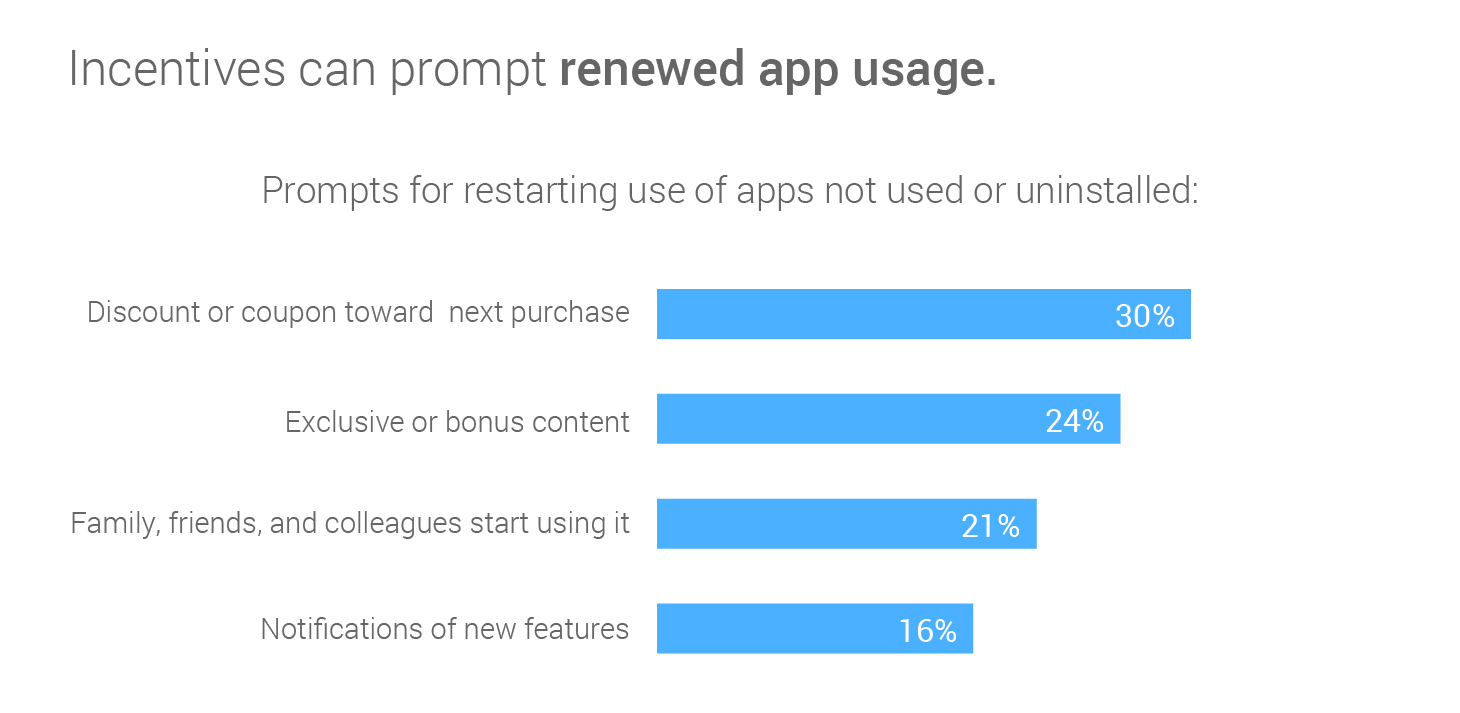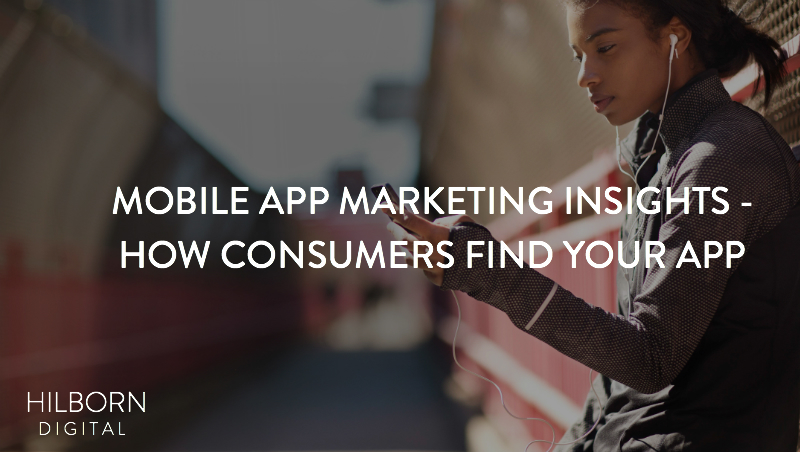People download new apps every day, but the truth is that many of them are abandoned or never even used. We uncover how people discover and engage with apps—and what brands can do about app marketing.
Before you enjoy that cup of coffee each morning, chances are you’ve already turned to a mobile app to start your day. Whether it’s finding your way to a meeting, logging your fitness routine, or even adding the cost of that latte to your weekly budget, one thing is clear: Apps are now an integral part of our daily micro-moments, with people spending an average of 30 hours per month in them, according to Nielsen. Apps play a key role in those I-want-to-know, I-want-to-go, I-want-to-do, I-want-to-buy moments.
They’re also a powerful way for brands to build deeper relationships with their customers. A mobile app marketing strategy can complement a brand’s offline experience (in-store special offers, for example), drive e-commerce, or simply help connect a brand with its loyal customers. Together with mobile websites, they’ve become important to both consumers and marketers.
So how can brands best tap into these vast app-consuming audiences? To find out how consumers are using apps, we conducted research with Ipsos MediaCT. Surveying 8,470 people with smartphones who had used apps in the previous week, we uncovered new insights into what drives consumers to install and engage with mobile apps. For example, one in four installed apps is never used, according to our research. So, what causes people to abandon an app?
Here we’ll dig deeper into these insights so that you can develop an effective mobile app marketing strategy. Two integral points in that strategy are boosting awareness of your app and keeping your app audience engaged.
App discovery doesn’t just happen in the app store
Marketers may assume that consumers head to an app store to find new apps—and a good portion does. In fact, 40% of smartphone users browse for apps in app stores. They remain a popular way to find new apps, from the latest in gaming to fitness tracking, music streaming, and much more. App stores are not the only way to discover apps, though.
People are finding out about apps in all kinds of instances while using their smartphones—when they’re engaged in an app, searching for another specific app, watching a YouTube video, or even surfing a mobile website. Search is a major source for app discovery, according to our research: One in four app users discovers an app through search. Say, for example, a business traveler has to fly to Miami on short notice and needs to find a place to stay. He heads to Google Search to look for “hotels in Miami” and finds an app that lists available local hotel rooms and short-term rentals. Because he’s a frequent traveler, he decides to download the app to help him book his stay.
Discovery through a search engine is especially prevalent for local apps, as are the tech (looking for reviews of new gadgets, for example) and travel (such as wanting to confirm trip details) categories. In these three categories, people are 26% (local), 59% (tech), and 30% (travel) more likely than the average to use search to find the apps they seek.
Take action: Make your app discoverable everywhere, including search
People not only turn to search to find new apps; they actually download apps because of search ads. They’re among the most effective ad formats for driving app downloads: Of those who downloaded an app based on an ad viewed on their smartphone, 50% said they were prompted to do so by a search ad. This shift in how consumers find and learn about new apps paves the way for marketers to rethink their brand’s approach to app marketing. And there’s good reason to tap into search to help boost app awareness. Search ads don’t just raise app visibility; they also drive app downloads—by being there at the exact moment when a consumer is actively looking for apps.
For marketers, this means making sure your app stands out wherever smartphone users are looking to discover apps relevant to their interests. And with Statistics reporting that over 3 million mobile apps are currently available for download, that factor is more important than ever in today’s flooded app market.
Ad Types Influencing App Downloads
How do you get your app noticed? You can increase visibility by focusing your app promotion on a consumer experience designed for downloads, using mobile app install campaigns, for example. This way, your brand is able to reach broader audiences while looking for an app similar to yours. In addition to search, extending your campaign across ad formats that drive app installations, including display and video, can help people discover your apps anywhere.
HotelsCombined, for example, introduced Google Search and AdMob to its mobile app marketing strategy in 2014. Downloads of its app, which compares hotel prices across hundreds of sites and apps for destinations all over the world, increased 150% from July to August, and there was a 20% lower cost per acquisition than on any other network. By implementing Google’s search and display app promotion campaigns, HotelsCombined helped people discover its app on a global scale.
App engagement and reengagement is key, as app users tend to lose interest
People turn to apps to ease their daily grind. And they’re more likely to use them if they serve a specific purpose. Our research revealed that two in three will use an app frequently when it simplifies their lives. For example, you can use a retail app, such as that of Walgreens’, to look for deals—sale items and coupons—while you’re shopping in-store. Apps can be quite helpful during a customer’s purchase journey. In fact, one in two app users turns to them to find information about a business or product or even to make a purchase.
The flip side is that apps can also be abandoned immediately after that transaction. Thirty-eight percent of those surveyed said they’re likely to download an app when it’s required to complete a purchase. Once they’ve completed that purchase, however, half will uninstall that just downloaded app and move on.
So, what was it about an app that attracted users in the first place? How can brands ensure that their apps are used not just once but again and again? The answer is simple: Prove the value and utility of your app.
Brands can avoid getting lost in the app fog if they provide clear value. For example, Sephora enhanced its in-store shopping experience with an app that lets shoppers scan all products for additional information. The brand also offers in-store pickup of items purchased online. Sephora is sending a clear message that it understands what its customers want during every micro-moment of their purchase journey.
Take action: Make your app’s value clear
App users need an incentive to re-engage with an app they’ve abandoned. And there are ways to draw app users back to your brand. Thirty percent of those surveyed in our research say they’d start using an app again if they were offered a discount toward a purchase, and nearly a quarter of app users would return if they received exclusive or bonus content. This is particularly true for the travel and retail categories: Those surveyed said they would use a travel (40%) or retail (47%) app again if they received a discount or coupon offer.
 Mobile app engagement ads can help remind users about your app’s value and get them back to your app. Let’s say someone is about to participate in a marathon and needs a pair of running shoes so she searches for “women’s running shoes.” As it turns out, she already has a shopping app installed on her smartphone that she used to find a lightweight running jacket last summer. The same app could reach out to her through a mobile app engagement ad (across search and display), reminding her of its presence and alerting her to a discount on running shoes.
Mobile app engagement ads can help remind users about your app’s value and get them back to your app. Let’s say someone is about to participate in a marathon and needs a pair of running shoes so she searches for “women’s running shoes.” As it turns out, she already has a shopping app installed on her smartphone that she used to find a lightweight running jacket last summer. The same app could reach out to her through a mobile app engagement ad (across search and display), reminding her of its presence and alerting her to a discount on running shoes.
Given the sheer number of apps available in the market, it’s more challenging than ever to gain an app user’s attention. That’s why your app needs to stand out from the crowd—both in and outside of an app store—so people can find it and use it, again and again. To make sure your app makes the cut, it’s important to show that it has clear value for your users, well past the initial app download.
These findings from our research can help your brand develop mobile app marketing strategies that will be successful not only in attracting but also in keeping an audience—bringing tremendous value to your business.
Curious how your sites SEO ranks? Check out your score now with our free website audit tool!
Enter any keyword or phrase to see how optimized your site is
[MySiteAuditor id=5]


